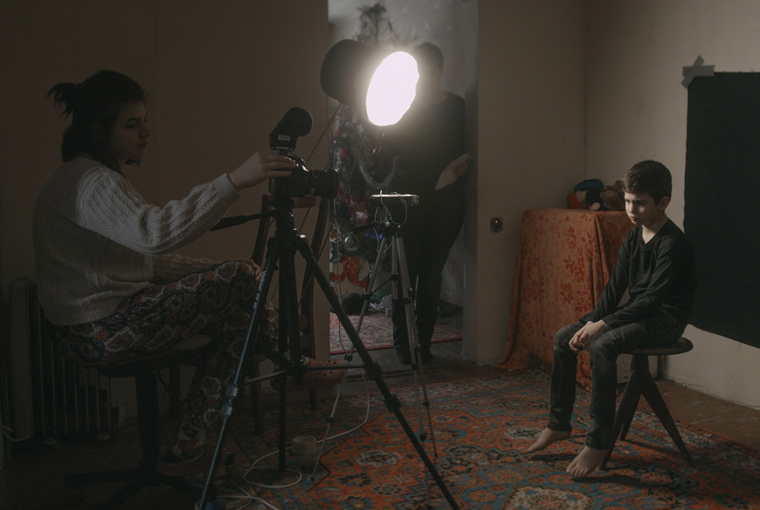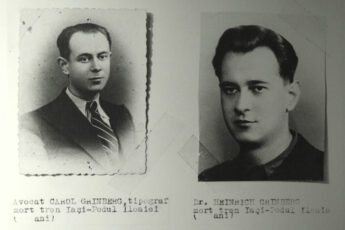Orange is the New Blue
Iryna Tsilyk’s The Earth Is Blue as an Orange (2020)
Vol. 103 (March 2020) by Zoe Aiano
As the shelling in the Donbass dwindles, the scars still remain fresh for both the urban landscapes and the people who live in them. In the heart of the “red zone”, Ganna and her children are collaborating on a film based on their memories of the critical period in 2014, when they found themselves regularly taking shelter in their cellar as their friends and neighbors fled. While the project ostensibly begins as her daughter Myra’s submission for film school, all of the members of the family are clearly invested in it emotionally and creatively. In following this process, Iryna Tsilyk’s documentary Earth is Blue as an Orange offers two perspectives: everyday life in a recovering war zone, and a meta-discourse on the relevance of storytelling for processing collective and individual trauma.
In both cases, the film handles the subject matter with subtlety, relegating all of the drama and politics to the background while leaving the focus squarely on the characters. Appropriately, then, the scenes are beautifully filmed without being distractingly cinematic.
When Myra and her friend have their high school graduation photos taken, they stand against a backdrop of bullet-marked buildings with army trucks casually driving behind them. The girls pay no attention – this is simply how the world looks now – and no further analysis is made. The real emotion in the film centers on normal human challenges and victories. It’s impossible not to be moved by the tension both mother and daughter feel in the lead-up to Myra’s entrance exam for university, and their ecstatic joy when they find out she is accepted. War or no war, life goes on, as evidenced by the never-ending stream of kittens constantly appearing in the family home. Myra also testifies to the universality of the teenage experience, with her palpable angst erupting as huffy outbursts, culminating in her cutting her ex-boyfriend out of all her old photos.
One of the unspoken themes that materializes is the endurance of women, and the emergence of a new kind of matriarchy given the absence of men. The only visible adult men are soldiers, and the audiences at the various public events that take place are almost exclusively female. Ganna is entirely self-sufficient as the head of the household and takes care of everything, from pulling out baby teeth to sweeping the chimneys. All the responsibility for deciding how to react to the conflict falls on her shoulders, and in a particularly moving moment she reveals how difficult it was to choose whether to abandon her home and her parents or force her own children to keep living in a war zone. However, the film also makes sure to point out that the disappearing men have not necessarily left to fight but also out of economic reasons, hinting at the lack of a functioning social infrastructure.
In terms of the film being produced by the family, the act in itself is clearly as significant as the final outcome, aside from the fact of it enabling Myra to pursue her dreams of becoming a cinematographer. In re-enacting their worst moments, they acquire a sense of dominance over the experiences that were forced upon them. The fact of it being collaborative is particularly significant in that it also provides a framework for sharing their memories and fears. The climax of the film is a scene in which each of the family members takes turns to sit in front of the camera and say their piece. Firstly, this set-up creates the opportunity for them to articulate their impressions in surprising and touching ways – one of the youngest boys defines war as “when people shoot, and other people shoot the people who shot first”, while Myra claims “war is emptiness”. What makes it so especially moving is the shared nature of the moment, with them hearing and reacting to each other. When the film is finally finished and presented at the bomb-scarred local music school, Tsilyk pointedly chooses not to show the film itself but rather the faces of the audience members, who watch enraptured with tear-filled eyes. This notion of the importance of being able to tell your own story lies at the heart of Earth is Blue as an Orange, but it also rings true at the level of the film industry itself. While it is entirely unrealistic and largely undesirable for every single individual to immortalize their life story on screen, it nevertheless poses hugely important questions regarding both who gets control of the narrative in crisis situations and the media structures that perpetuate these hierarchies. By allowing the people affected to speak for themselves, films such as these remind us of the tangible, personal results of abstract ideological discourse.




What about Paul Eluard’s love poem the first line of which has been appropriated as the title of the so-called ‘documentary’?